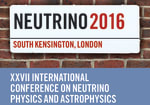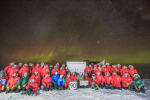The sky was not disappointing anyone last week at the Pole; it had it all—stars, Milky Way, and auroras. Work-wise it was rather quiet for IceCube’s winterovers. But they had other activities going on, including emergency response training and showcasing their LEGO creations in a blog post for LEGO fans. […]
News
IceCube search for cosmogenic neutrinos favors heavy nuclei cosmic-ray sources
The IceCube Collaboration has made public today that a new search for cosmogenic neutrinos resulted in two very high energy neutrinos. These neutrinos, which are found to be of astrophysical origin with a 92.3% probability, include the highest energy neutrino detected to date. While of astrophysical origin, the energy of these neutrinos does not match the expectation for a cosmogenic neutrino flux. The lack of evidence for such events in a search of seven years of IceCube data places very strong constraints on the sources of UHECR. Proton-dominated sources are greatly disfavored, and testing mixed and heavy nuclei cosmic-ray sources will require much bigger instruments, such as an extension of IceCube or radio Askaryan neutrino detectors. These results have been submitted yesterday to Physical Review Letters. […]
IceCube aims for neutron astronomy
The IceCube Collaboration presents results from a search for sources of high-energy neutrons using four years of data from IceTop, the surface detector array. Researchers have not found any evidence for astrophysical neutrons, but the results have allowed the collaboration to set new limits that constrain the possible galactic neutron sources. These results have just been submitted to the Astrophysical Journal. […]
Rethinking PINGU, a world-class instrument for neutrino oscillation studies
The Precision IceCube Next Generation Upgrade (PINGU) is the proposed infill extension in a region at the center of the IceCube Neutrino Observatory that will lower the energy threshold to a few GeV, dramatically increasing both the number of GeV-scale neutrinos detected by IceCube and, more importantly, the precision with which they are measured. […]
Week 26 at the Pole
South Pole, dead of winter, no sun for months. So, that rules out a rainbow in the above image. Instead it’s an aurora, but it was doing its best, with its graceful arch, to imitate a rainbow. […]
IceCube at Neutrino 2016
IceCube researchers are once more joining the longstanding biennial Neutrino conference. The 27th International Conference on Neutrino Physics and Astrophysics, Neutrino 2016, started on Monday in London, England, and runs through Saturday, July 9. […]
Week 25 at the Pole
It’s the middle of winter at the South Pole, and not only is it dark outside, but there are restrictions in place to keep it as dark as possible (exterior lights limited to a red spectrum, to reduce interference) for the benefit of research projects that rely on the dark night sky. […]
Week 24 at the Pole
Last week, they were observing midwinter at the South Pole station, which traditionally includes a fancy dinner and a viewing of “The Shining.” […]
Week 23 at the Pole
A completed jigsaw puzzle serves as a base for holding a sizeable LEGO creation. This model looks to be of London’s Tower Bridge, but perhaps someone should talk to the LEGO folks about designing one for the ICL (the IceCube Lab). Wouldn’t that be fun? […]
Week 22 at the Pole
Last week at the Pole the entire winterover crew got together to take a group photo. They normally do this each year, but not always with such spectacular results. This year they chose an outdoor venue with an aurora backdrop. […]









